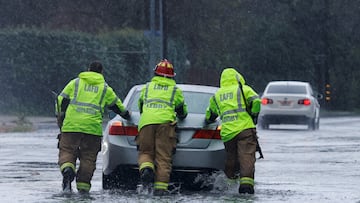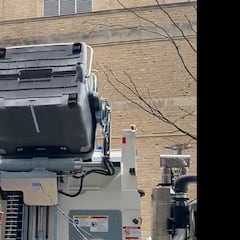Storm warning in California: what is a flash flood?
Sections of California are under a state of emergency as a second atmospheric river flows over the Golden State prompting flash flood warnings.

A second atmospheric river is dumping heavy rain on southern California and has prompted the National Weather Service to issue flash flood warnings. “This is a DANGEROUS SYSTEM with major risks to life and property,” warned the federal meteorological agency and it presents a “high risk for life-threatening and damaging flooding.”
California Governor Gavin Newsom has declared a state of emergency in eight counties including Los Angeles, Orange, Riverside, Santa Barbara, San Bernardino, San Diego, San Luis Obispo and Ventura counties. On Sunday 4 February, Downtown LA received 4.10 inches of rain, exceeding the daily record set in 1927 of 2.55 inches according to the NWS Los Angeles.
Storm warning in California: what is a flash flood?
Unlike a regular flood which is an “inundation of normally dry area caused by rising water in an existing waterway, such as a river, stream or drainage ditch,” which could last days or weeks, a flash flood occurs over a short period of time. Heavy or excessive rainfall, generally over less than six hours, generate raging torrents of water. These then “rip through river beds, urban streets, or mountain canyons sweeping everything before them,” according to the NWS.
Flash floods can also be caused when a levee or dam fails as well as the release of water trapped behind an ice or debris jam.
Millions on alert for landslides and life-threatening flash floods as a new round of storms hits the West Coast. @ginger_zee has the latest. https://t.co/nffjeYHz0H pic.twitter.com/tvzaPkC36P
— Good Morning America (@GMA) February 5, 2024
How soon after it rains does flash flooding occur?
Flash floods can occur within a few hours of the excessive rainfall or just a matter of minutes. The rapidity of the events can catch people off-guard while traveling or at home or work. The fast-moving water may rise quickly trapping people where they are.
The speed with which flash flooding occurs depends on numerous factors including “intensity of the rainfall, the location and distribution of the rainfall, the land use and topography, vegetation types and growth/density, soil type, and soil water-content.” Flash flooding in urban areas is generally faster and more severe than in suburbs or the countryside due to the presence of more impervious surfaces which “do not allow water to infiltrate the ground, and the water runs off to the low spots very quickly.”
Do not under estimate water crossing a road
It is cautioned that drivers or pedestrians that encounter a road or area inundated by a flash flood should not try to cross the water. The number one rule is that you should turn around. Six inches of water can reach the bottom of most passenger vehicles and cause loss of control and steering.
Related stories
One foot of water can cause many vehicles to float away. Two feet of water can carry away an SUV or pickup truck.
Under a flash flood warning?
— FEMA (@fema) February 1, 2024
Tips from @Readygov: Avoid driving if possible. Road conditions may change within a matter of a few miles & six inches of water can start to cause problems with your vehicle. Pay attention to barricades & do NOT drive through floodwaters. pic.twitter.com/j9Quh9bC3f
Follow all the latest news on AS USA.


